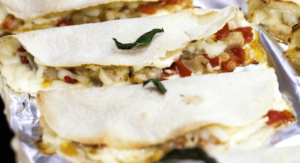Pumpkin seeds, also known as pepitas, are the edible seeds found inside pumpkins, a type of squash in the Cucurbitaceae family.
They have a flat, oval shape and a greenish color when hulled. Pumpkin seeds have been cultivated for thousands of years and are native to the Americas, particularly Mexico and Central America.
Cultural Significance in Mexican Cuisine:
Pumpkin seeds hold cultural significance in Mexican cuisine, dating back to ancient indigenous cultures such as the Aztecs and Mayans. They were a staple food in the diets of these civilizations and were highly valued for their nutritional richness.
Pumpkin seeds were used not only as a food source but also in various cultural rituals and medicinal practices. They were ground into a paste to create sauces, added to stews and dishes, and sometimes even used as currency.
Why Pumpkin Seeds Are Used in Mexican Cooking:
- Flavor and Texture: Pumpkin seeds have a mild, nutty flavor that adds depth to dishes without overpowering other ingredients. When toasted or roasted, they acquire a crunchy texture, enhancing the overall eating experience.
- Versatility: Pumpkin seeds are versatile and can be used in various forms. They can be consumed raw, roasted, ground into pastes or sauces, and added to both savory and sweet dishes.
- Nutritional Value: Pumpkin seeds are rich in nutrients like protein, healthy fats, fiber, vitamins (such as vitamin E and B-complex vitamins), minerals (such as magnesium, zinc, and iron), and antioxidants. They contribute to the nutritional profile of dishes, offering health benefits.
- Traditional Culinary Role: In Mexican cuisine, pumpkin seeds are a key ingredient in various sauces and dishes, notably mole sauces. They are ground and combined with other ingredients like chilies, spices, and sometimes chocolate, to create rich and complex sauces with layers of flavor.
- Texture Enhancer: Ground pumpkin seeds can act as a thickening agent or add creaminess to dishes, contributing to the texture and consistency of certain recipes.
Overall, pumpkin seeds play an essential role in Mexican cuisine by adding flavor, texture, and nutritional value to a wide range of traditional dishes, contributing to the unique and diverse culinary heritage of the region.
Use of Pumpkin Seeds in Mexican Recipes:
Pumpkin seeds, known as pepitas in Mexican cuisine, are a versatile ingredient used in various traditional dishes:
- Mole Sauces: Pumpkin seeds are a fundamental component in several mole sauces, including Mole Poblano, contributing to their complex flavor profile. They are toasted, ground, and blended with other ingredients like chilies, spices, chocolate, and more to create rich, savory sauces with a hint of nuttiness.
- Pipian Verde: This is a traditional Mexican sauce made with pumpkin seeds, green chilies, and herbs. Pumpkin seeds are toasted and ground, then combined with other ingredients to make a flavorful sauce, often served with chicken or pork.
- Salads and Garnishes: Pumpkin seeds are commonly used as a topping or garnish in salads, adding texture, crunch, and a nutty flavor. They can be toasted and sprinkled over salads or soups, enhancing their taste and visual appeal.
- Snacks and Sweets: In Mexican cuisine, pumpkin seeds are sometimes candied or roasted and seasoned with spices like chili powder or cinnamon, creating a popular snack called “pepitoria” or used in sweets and desserts.
Flavors Added by Pumpkin Seeds:
Pumpkin seeds have a distinctive flavor profile that adds depth and nuttiness to dishes:
- Nutty: When toasted or roasted, pumpkin seeds develop a nutty taste, enhancing the overall flavor of the dish without being overpowering.
- Mild and Earthy: They have a mild earthy flavor that complements various ingredients in both savory and sweet dishes without dominating the dish’s taste.
- Textural Element: Besides flavor, pumpkin seeds contribute to the texture of dishes. When ground, they can add thickness and creaminess to sauces while also providing a slight graininess.
- Versatility: Their versatility allows them to blend well with other flavors, whether incorporated into complex sauces like mole or used as a simple topping for salads, providing an extra layer of taste and texture.
In Mexican cuisine, pumpkin seeds are prized for their flavor, versatility, and nutritional benefits. They play a pivotal role in adding depth, complexity, and texture to dishes, making them an integral part of the culinary heritage of the region.
Preparing Pumpkin Seeds for Cooking:
- Cleaning: Remove the seeds from the pumpkin, separating them from the pulp and strands. Rinse the seeds under cold water in a colander, removing any remaining pumpkin flesh.
- Drying: Pat the cleaned seeds dry with paper towels or allow them to air-dry on a baking sheet. Ensure they are completely dry before roasting for a crispier texture.
- Roasting:
- Preheat the oven to around 300°F (150°C).
- Toss the dried seeds with a small amount of oil (such as olive oil or melted butter) and seasonings of your choice, like salt, garlic powder, chili powder, cumin, or cinnamon, depending on the desired flavor profile.
- Spread the seasoned seeds in a single layer on a baking sheet.
- Roast for approximately 20-30 minutes, stirring occasionally, until the seeds turn golden brown and crispy. Keep an eye on them to prevent burning.
- Cooling: Once roasted, let the seeds cool completely before using them in recipes or storing them in an airtight container for snacking or later use.
Creative Ways to Use Pumpkin Seeds Beyond Traditional Recipes:**
- Trail Mix: Combine roasted pumpkin seeds with dried fruits, nuts, and chocolate chips to create a homemade trail mix for a nutritious snack.
- Crunchy Topping: Sprinkle roasted pumpkin seeds on top of yogurt, oatmeal, or breakfast bowls for added crunch and nutrition.
- Pesto or Sauce: Blend toasted pumpkin seeds with herbs, garlic, olive oil, and Parmesan cheese to create a unique pesto or sauce for pasta or as a dip.
- Breading or Coating: Grind roasted pumpkin seeds and use them as a crunchy coating for chicken, fish, or tofu instead of traditional breadcrumbs.
- Garnish for Soups: Use roasted and seasoned pumpkin seeds as a garnish for soups, adding texture and flavor to dishes like butternut squash soup or vegetable stews.
- Homemade Granola: Incorporate roasted pumpkin seeds into homemade granola mixes for an added nutritional boost and crunchy texture.
- Salad Toppers: Sprinkle roasted pumpkin seeds over salads to add texture and nutty flavor, enhancing the salad’s taste profile.
Get creative by adding roasted pumpkin seeds to various dishes and snacks, experimenting with different flavor combinations and applications to enjoy their nutty taste, texture, and nutritional benefits in versatile ways.
Nutritional Profile of Pumpkin Seeds:
Pumpkin seeds are a nutrient-dense food, containing a variety of essential nutrients:
- Protein: They are a good source of plant-based protein, containing all essential amino acids, aiding in muscle repair and growth.
- Healthy Fats: Pumpkin seeds are rich in unsaturated fats, including monounsaturated and polyunsaturated fats like omega-3 and omega-6 fatty acids, supporting heart health.
- Fiber: They contain both soluble and insoluble fiber, aiding digestion and promoting gut health.
- Vitamins: Pumpkin seeds are a source of various vitamins, including vitamin E, an antioxidant that supports immune function, skin health, and cell protection against damage. They also contain B-complex vitamins like niacin, riboflavin, folate, and pantothenic acid, which are crucial for energy production and metabolism.
- Minerals: Pumpkin seeds are rich in minerals such as magnesium, zinc, iron, and potassium. Magnesium supports bone health, muscle function, and energy production. Zinc is essential for immune function and wound healing, while iron is vital for oxygen transport in the blood.
Health Benefits of Pumpkin Seeds:
- Heart Health: The high content of unsaturated fats, magnesium, and antioxidants in pumpkin seeds may contribute to heart health by lowering blood pressure, reducing LDL (bad) cholesterol levels, and decreasing the risk of cardiovascular diseases.
- Immune Support: The presence of zinc, antioxidants like vitamin E, and other nutrients in pumpkin seeds supports immune function, helping the body fight off infections and illnesses.
- Prostate Health: Some studies suggest that pumpkin seed consumption might support prostate health in men, potentially reducing the risk of benign prostate enlargement.
- Antioxidant Properties: The antioxidants found in pumpkin seeds, such as vitamin E and carotenoids, help neutralize free radicals, protecting cells from oxidative damage and reducing the risk of chronic diseases.
- Improved Sleep: Pumpkin seeds contain tryptophan, an amino acid that aids in the production of serotonin, promoting better sleep and potentially alleviating insomnia.
- Blood Sugar Regulation: The fiber and healthy fats in pumpkin seeds may help regulate blood sugar levels, benefiting individuals with diabetes or insulin resistance.
Incorporating pumpkin seeds into the diet as a snack, salad topping, or as an ingredient in various dishes can contribute to overall health and provide a range of essential nutrients, supporting various bodily functions and potentially reducing the risk of certain health conditions.
Storage and Shelf Life of Pumpkin Seeds:
Proper storage helps maintain the freshness and extends the shelf life of pumpkin seeds:
- Room Temperature: Store roasted or raw pumpkin seeds in an airtight container or resealable bag at room temperature in a cool, dry place away from heat and moisture. Properly stored, they can last for several months.
- Refrigeration or Freezing: For longer-term storage, particularly if you live in a warm or humid climate, consider storing pumpkin seeds in the refrigerator or freezer. Place them in an airtight container or freezer bag to prevent moisture or odors from affecting their quality. Frozen pumpkin seeds can last for up to a year.
- Sealed Containers: Ensure the storage container for pumpkin seeds is tightly sealed to prevent exposure to air, which can cause them to become rancid faster.
- Check for Spoilage: Before consuming stored pumpkin seeds, check for any signs of spoilage such as an off smell, change in color, or rancid taste. If they appear or smell different, discard them.
Allergies and Considerations:
Pumpkin seeds are generally considered safe and nutritious for most people, but allergies or sensitivities may exist:
- Allergies: Some individuals may have an allergy to pumpkin seeds. Allergic reactions might include itching, swelling of the lips or throat, hives, difficulty breathing, or digestive issues. If you suspect an allergy, seek medical advice.
- Cross-Reactivity: Individuals allergic to certain foods, such as nuts or seeds (e.g., peanuts or sesame seeds), may also have a higher risk of developing an allergy to pumpkin seeds.
- Oxalates: Pumpkin seeds contain oxalates, compounds that, in large quantities, can crystallize and cause health issues for individuals prone to kidney stones or certain kidney conditions. Moderation is recommended for those susceptible to oxalate-related problems.
- Digestive Sensitivities: Some individuals may experience digestive discomfort, such as bloating or gas, when consuming large quantities of pumpkin seeds due to their fiber content.
As with any food, if you have known allergies, sensitivities, or specific dietary concerns, it’s advisable to consult a healthcare professional or allergist before incorporating pumpkin seeds into your diet to ensure they are safe for your consumption.





